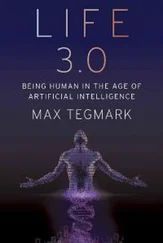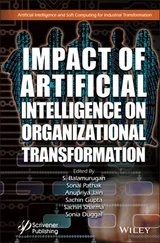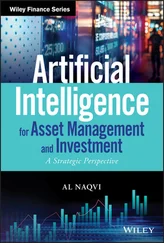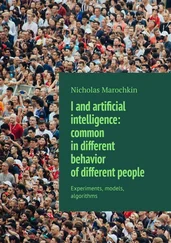Jason L. Anderson - Artificial Intelligence for Business
Здесь есть возможность читать онлайн «Jason L. Anderson - Artificial Intelligence for Business» — ознакомительный отрывок электронной книги совершенно бесплатно, а после прочтения отрывка купить полную версию. В некоторых случаях можно слушать аудио, скачать через торрент в формате fb2 и присутствует краткое содержание. Жанр: unrecognised, на английском языке. Описание произведения, (предисловие) а так же отзывы посетителей доступны на портале библиотеки ЛибКат.
- Название:Artificial Intelligence for Business
- Автор:
- Жанр:
- Год:неизвестен
- ISBN:нет данных
- Рейтинг книги:4 / 5. Голосов: 1
-
Избранное:Добавить в избранное
- Отзывы:
-
Ваша оценка:
- 80
- 1
- 2
- 3
- 4
- 5
Artificial Intelligence for Business: краткое содержание, описание и аннотация
Предлагаем к чтению аннотацию, описание, краткое содержание или предисловие (зависит от того, что написал сам автор книги «Artificial Intelligence for Business»). Если вы не нашли необходимую информацию о книге — напишите в комментариях, мы постараемся отыскать её.
Artificial Intelligence for Business — читать онлайн ознакомительный отрывок
Ниже представлен текст книги, разбитый по страницам. Система сохранения места последней прочитанной страницы, позволяет с удобством читать онлайн бесплатно книгу «Artificial Intelligence for Business», без необходимости каждый раз заново искать на чём Вы остановились. Поставьте закладку, и сможете в любой момент перейти на страницу, на которой закончили чтение.
Интервал:
Закладка:
Case Study #3: BlackRock, Inc.
Financial markets are a hotbed for data. The data can be collected accurately and in real time for most financial instruments (stocks, options, funds, etc.) listed on stock markets. Metadata (data about data) can also be curated from analytical reports, articles, and the like. The necessity for channeling the sheer amount of information that is generated every day has given rise to professional data stream providers like Bloomberg. The immense quantity of data available, along with the potential for trend prediction, growth estimations, and increasingly accurate risk assessment, makes the financial industry ripe for implementing AI projects.
BlackRock, Inc., one of the world's largest asset managers, deploys the Aladdin 5 (Asset, Liability, Debt, and Derivative Investment Network) software, which calculates risks, analyzes financial data, supports investment operations, and offers trade executions. Aladdin's key strength lies in using the vast amount of data to arrive at models of risk that give the user more confidence in deploying investments and hedging. The project was started nearly two decades ago, and it has been one of the key drivers of growth at BlackRock. BlackRock's technology services revenue grew 19 percent in 2018, driven by Aladdin and their other digital wealth products. 6 Aladdin is now used by more than 25,000 investment professionals and 1,000 developers globally, helping to manage around $18 trillion in assets. 7 Aladdin embeds within itself the building blocks of AI through the use of applied mathematics and data science.
BlackRock is now setting up a laboratory to further study the applications of AI in the analysis of risk and data streams generated. The huge amount of data being generated is becoming a problem for analysts, since the amount of data a human can sift through is limited. The expectation of Rob Goldstein, BlackRock's chief operating officer, is that the AI lab will help increase the efficiencies in what BlackRock does across the board. 8 By applying big data to their existing data trove, BlackRock will be able to generate higher alphas, a measure of excess return over other portfolio managers, according to David Wright, head of product strategy in Europe. With good data generated by Aladdin and a sufficiently advanced AI algorithm, BlackRock might just emerge as the leader in analyzing risk and portfolios.
How to Get Started
The journey to adopt AI promises to bring major changes to the way your organization thinks and approaches its future. This journey will involve the adoption of new methods and process improvements that will aid you in spotting the novel ways AI can be deployed to save costs and make available new opportunities.
As with any endeavor worth starting, we must make plans for how we intend to accomplish our goal. In this case, the goal is to adopt AI technologies to better our organization. The plan for achieving this goal can vary from organization to organization, but the main steps invariably remain the same (see Figure 1.2).
1. Ideation
The first step in any technology adoption journey must start with ideation and identifying your motivation. In this chapter, we will delve into answering questions such as “What problem are you trying to solve?,” “How does your organization operate today?,” and “How do you believe your organization will be able to benefit from AI technology?” Answering questions like these will kick-start your AI journey by establishing a clear set of goals. To properly answer these questions, you will also need a general understanding of the technology, which we will cover in the following section.
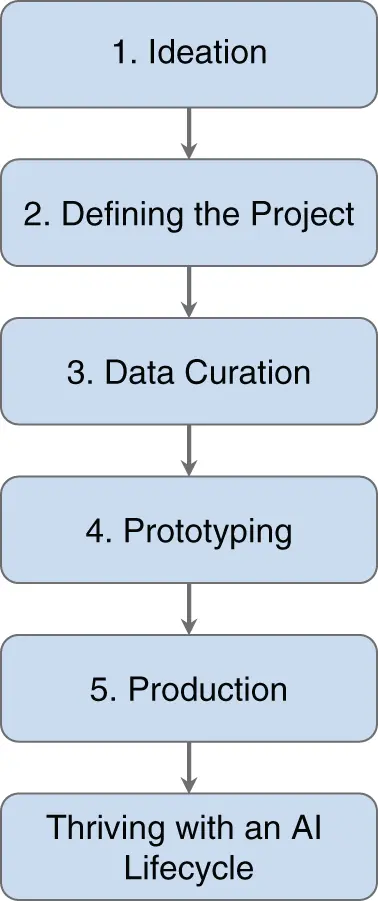
FIGURE 1.2 The AI Adoption Roadmap
2. Defining the Project
Once you have determined that the use of AI technologies can help improve your organization or solve a business problem, you must then get specific about what you hope to achieve. During the second step, you will outline specifically which improvements you plan to attain, or which problems you are trying to solve. This will take the form of a project plan. This plan will act as a guiding document for the implementation of your project. Using the methodical techniques of design thinking, the Delphi method, and systems planning makes a plan much easier to develop. These techniques will ensure that you have a sound and realistic project plan.
User stories will also be a large part of the project plan. User stories are an excellent way to break down a project into functional pieces of value. They define a user, the functionality that the system will provide for the user, and the value that the function will provide to the organization. Well-defined user stories also quantify their results to empirically know when success has been achieved. These success criteria make it much easier to see when we have accomplished our user story's goal and communicate a clear course of action for everyone involved. Specificity is the key.
3. Data Curation and Governance
Data is paramount to every AI system. A system can only be as good as the data that is used to build it. Therefore, it is important to take stock of all the possible data sources at your disposal. This is true whether it is data being collected and stored internally or data that you externally license.
After you have identified your data, it is time to leverage technology to further improve the data's quality and prepare it to train an AI system. Crowdsourcing can be a valuable tool to enhance existing data, and data platforms such as Apache Hadoop can help consolidate data from multiple sources. Data scientists will be key in orchestrating this process and ensuring success. The quality of your data will determine the success of your project in a huge way. It is therefore essential to choose the best available data on hand. The old saying about “garbage in, garbage out” applies to AI as well.
4. Prototyping
With your project plan and data defined, it is time to start building an initial version your system. As with any project, it is best to take an iterative approach. In the prototype step, you will select a subset of your use cases to validate the idea. In this way, you are able to see if the expected value is materializing before you are completely invested. This step also enables you to adjust your approach early if you see any problems arise. Developing a prototype will help you to see, with actual results, whether the ideas and plans you defined in the previous steps have promise. In the event that they do not, you should be able to recover quickly and adjust them using the knowledge gained from prototyping, without the wasted investment of building a full system.
During the prototyping phase, it is necessary to have realistic expectations. With most AI systems, they improve with more data and parameter tweaking, so you should expect to see increasing improvements over time. Luckily, metrics like precision and recall can be empirically measured and used to track this improvement. We will also cover the cases when more data is not the answer and what other techniques can be pursued to continue improving the system.
5. Production
With a successful prototype under your belt, you have been able to see the value of the technology in action. Now it is time to further invest and complete your system. At this point, it is also a good idea to revisit your user stories and plan as a whole to determine if any priorities have changed. You can then proceed with building the production system.
Читать дальшеИнтервал:
Закладка:
Похожие книги на «Artificial Intelligence for Business»
Представляем Вашему вниманию похожие книги на «Artificial Intelligence for Business» списком для выбора. Мы отобрали схожую по названию и смыслу литературу в надежде предоставить читателям больше вариантов отыскать новые, интересные, ещё непрочитанные произведения.
Обсуждение, отзывы о книге «Artificial Intelligence for Business» и просто собственные мнения читателей. Оставьте ваши комментарии, напишите, что Вы думаете о произведении, его смысле или главных героях. Укажите что конкретно понравилось, а что нет, и почему Вы так считаете.

